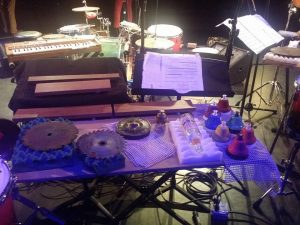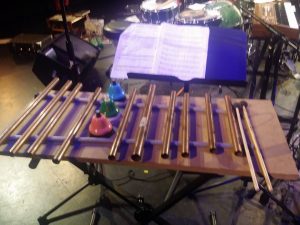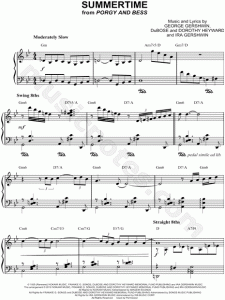An amazing concert I went to on January 9, 2017 at the Merkin Concert Hall was titled “Bang on a Can”. The band was made up of great musicians including six for most of the show and then eight during the second part of the show. The band not only played each instrument extremely well, but also seemed to have an amazing chemistry with each other and this in turn made each piece even more enjoyable to watch. The show featured seven composers who were great and their pieces were interesting and very colorful. There were eight pieces included in the show. Bang on a Can; a formidable concert based off of funds from the people’s commission, had its’ 30th year anniversary showcasing the owners, composers, and most of all the Bang on a Can’s All Stars. There was great dialogue from the Host John Schaefer, who is also the radio host of WNYC on the 93.9 FM radio station. There was a great ambience in the venue because it was warm, huge and full of seats. Before each piece was played, the composers were called onto the stage by John Schaefer and had a mini interview about the piece, and how they came up with the idea for the music.
During the first part of the show, the performers in the band stayed the same for all of the pieces and during the second part they added Eliza Bagg on violin and voice and Charles Yang on violin and voice as well. The band was incredibly amazing; their energy for each piece was impeccable and they did not even look tired at the end of the show, which was roughly two hours. It featured David Cossin on Percussion, Derek Johnson on Electric Guitar, Robert Black on Solo Double Bass, Ashley Bathgate on Cello, Ken Thomson on Clarinets and Vicky Chow on Piano and Keyboard. When they were required to do so, they lent their voices to pieces as well. I think that the performers made the show amazing by giving their all to every piece.
The first half of the concert featured two pieces from composers from different parts of the world. During this part of the show, the composers had to use field recordings. They were asked to record something new or old in the field of sound and then write music to correspond with what they found. The piece by American composer and co-founder of Bang on a Can, David Lang who received a Pulitzer Prize in 2008 for one of his pieces, was titled sunray. Anna Thorvaldsdottir from Iceland, whose works have been nominated and awarded on many occasions, wrote a piece that was titled Fields. The piece by Juan Felipe Waller who is a Mexican-Dutch composer was titled Hybrid Ambiguities and the settings of his works vary from symphonic orchestra to chamber music and electronics. The piece by American composer Nico Muhly, who has written over 80 works for the concert stage, was titled Comfortable Cruising Altitude. The pieces featured Field Recordings incorporated into them which were either old recordings or new recordings found in real life and I was pleasantly surprised at how seamlessly they were woven into the pieces.
David Lang said sunray was inspired by masonic shapes and bringing life to physical form in music. The piece had many dissonances and used cool pizzicato chords from the strings, repetitious modulation and subtle dynamic build-up. The percussionist literally played everything; he would switch from the vibraphones to bells. He used broken rhythms and the piece gradually got stronger and louder as the percussionist went to the drum set. David Lang indeed illuminated the building with his amazing piece.
Anna Thorvaldsdottir was one of the international composers that contributed to Bang on a Can. Her piece had live, natural textures that made you feel as if you were running through fields. She mentioned she was influenced by actual fields in Iceland to write this piece. Random piano and guitar trills and scale runs were used with clarinet tonguing, breaths and spits to give the song a natural live feel. The string section held long suspenseful notes and the drummer used like a choked snare sound by using conga drum slaps.
Juan Felipe highlighted a Korean Harp in Hybrid Ambiguities that was inspired by a friend. This piece was very experimental. That unique instrument had 96 tones, 12 semi-tones for each 8 notes in the scale. The drummer was smacking the vibraphones with the shaker; he used timpani, toms, and vibraphone. The bass clarinet held higher notes for a long period of time and the pianist which was also amazing helped create a hip-hop feel and pulse. The string section produced a speeding car sound. The guitarist used many chromatic notes. This piece was definitely awesome.
Nico Muhly was absent but Comfortable Cruising Altitude was ok. It used uneasy airplane noises, and babies crying on the plane. The drummer used a violin bow on his cymbal which I’ve never seen… ever. The decay and overtones of the crash cymbal were dramatically enhanced with one arc. The piece constantly resolved dissonances, had beautiful chords and there was deep distance between the left and right hand of the pianist covering low and high octaves. All of the pieces were adventurous and daring and the artists weren’t afraid to think outside of the box and make their pieces unique to their own personalities.
The artists in the second part of the show were American composers but that did not take away from how exotic and fresh the pieces were. There was a piece by Michael Gordon, a member of the Philharmonic known to add rock instruments to chamber music. His work was titled St. Remy from his opera Van Gogh and it happens to be his final movement. Julia Wolfe whose music pushes performers to extremes and demands audiences’ attention, composed a piece titled Believing and it included double bass chaos when he would move up and down sporadically. Then there were two pieces by Philip Glass, who has written music for experimental theater and Academy Award winning motion pictures, one titled Bed which has a consonance on off-beats from his opera Einstein on the Beach and the second one is titled Closing which included cello vibrato with shaking notes from his debut record Glassworks were included in the second part. Michael Gordon’s St. Remy was conducted by the clarinetist in common time but the band would start on an off-beat. There were group vocals from everyone on this song, there were a lot of half-step ascensions. Some of the lyrics used by the male singer and violinist were “I think I have done well”. These pieces were just as interesting and unique as the pieces in the first part of the show.
The show was amazing and very insightful. I enjoyed every piece, composer, and program. I learned plenty just from being in the front row, and I’m sure I got a different sonic experience being able to hear the unfiltered effect of the music. Thank you so much Professor Tilley, I definitely plan on going to more Bang on a Can concerts.




 Tigue
Tigue




